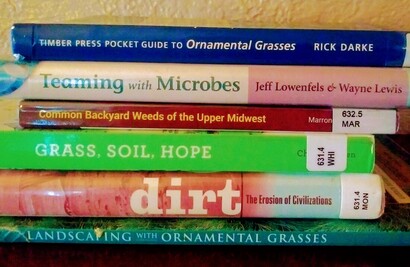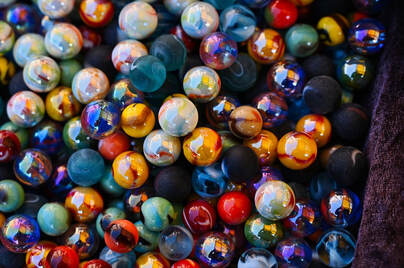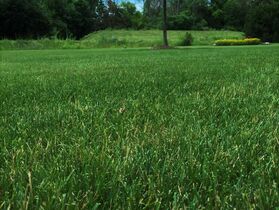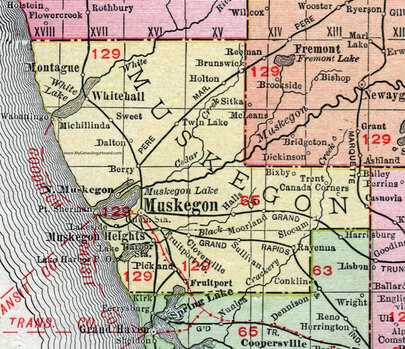 The off-season (November-March) at the Good Sweet Earth homestead is the time of year we like to recharge our batteries and expand our knowledge base. That means a little travel, a little rest, but also a lot of continuing education, research, workshops and reading. Steve (our lawn guy), has decided to focus on two areas of study this year: Learning as much as he can about common lawn weeds found in Michigan, and the physiology of ornamental grasses. That means, in addition to the usual reading about faming, soils, microbes, turf and vermicompost, he’ll be entering the 2020 growing season (hopefully!) with a whole new level of understanding of ornamental grasses and weeds, and how those relate to a healthier, more beautiful yard. So while some of our outside learning comes in the form of classes, much of it comes from good old-fashioned trips to the public library, and browsing the shelves for good books to fill the cold winter months. We thought we’d share with you some of what we’re reading this January, and how it’s informing and inspiring us as we enter a new year.
0 Comments
 This is a Q&A blog series on healthy organic turf. If you have a question for Good Sweet Earth's lawn guy, Steve, shoot him an email at [email protected], and include "Ask the Lawn Guy" in the subject line. Most people know what sandy soil and clay soil look like. They know that sandy soil is pretty loose and doesn't hold water very well. They know that clay soil can often feel hard and compacted. Most people also also know that nothing grows especially well in soil that's either of these two things. Somewhere in between sand particles and clay particles lies silt. Loam soil contains a balance of all three types of particles. So the question that I got recently was this: "How much sand should I add to my clay soil to loosen it up and make it usable?" And I suppose the counterpart to this question could be "How much clay should I add to sandy soil?" In short, the answer is: Don't bother. You'll make your soil even worse by trying to change its structure with sand or clay. Imagine your clay particles as marbles. Proportionally speaking, silt would be about the size of a basketball compared to those marbles. Now I had a hard time coming up with a real-world object that would be representative of a sand particle next to our marble-sized clay particle. The best I could come up with is this: Picture a ball slightly larger than a three-car garage. Yep. That's a sand particle next to a clay particle. Now imagine you had a field full of marbles. And you want to "loosen" things up. I don't care how many three-car garages you add to that field of marbles, you're never, ever going to end up with a field full of basketballs. You're just gonna have a bunch of really small balls and really large balls, and they're not going to work together for anyone's good because you're never going to have enough garage-balls to balance the little marbles. Ideally, healthy soil is equal parts marbles, basketballs and three-car garages. But getting that balance is so much harder than it sounds. I don't recommend attempting to change the mineral structure of your soil this way. So what is a clay-burdened or sand-burdened gardener to do? Two words: Organic matter. Clay-heavy soil has a very difficult time getting air through its tiny, tightly-bound particles. Roots also have a hard time moving through them. Organic matter, like compost or organic fertilizers, changes everything. This is the answer you seek, not sand. Mix that organic matter into your clay soil or top-dress it. Adding organic matter will make your clay soil usable in a way that adding sand never will. Likewise, if you're dealing with sandy soil (an especially common problem if you live by the Lake Michigan lakeshore), adding organic matter will help your soil retain water and nutrients so much better. Types of organic matter that you can add to your soil to make it healthier include basic compost (that many gardeners make in their own backyards), Worm Compost or Alfalfa Meal. Biochar (mixed with some sort of composted material) also makes for a terrific soil amendment. For really compacted clay soil, gypsum is a good, natural option for de-compacting it before adding organic matter. For compacted lawns with clay soil, aeration is a good option, best done in the fall, followed by a top-dressing of organic matter and/or gypsum.  This is a Q&A blog series on healthy organic turf. If you have a question for Good Sweet Earth's lawn guy, Steve, shoot him an email at [email protected], and include "Ask the Lawn Guy" in the subject line. I got this question via email last week: Give me one good reason why I should have an organic lawn. Modern science has given us tools to have a green lawn without weeds, why shouldn't I use them? I can do better than one good reason, I can give you three. First, healthy grass comes from healthy soil. Synthetic chemical fertilizers kill your soil, which in turn kills your turf and makes it overly reliant on chemicals. Dead, sterile soil is also a breeding ground for weeds and disease. Organic fertilization focuses on feeding your soil and developing a healthy ecosystem of bacteria, fungi, worms and other life below the surface of your yard. We use vermicompost (nutrient-rich compost made by earthworms), microbial tea (a liquid rich in microbes to help break down organic matter in your soil), and all-natural slow-release fertilizers. Modern science may have convinced us we can only grow a healthy yard with synthetic chemicals, but nature itself has given us the most effective ways to grow things: water, microbes and organic matter. We've only had synthetic chemicals for our lawns for about 60 years, but things grew just fine for billions of years before that. Second, many people in the United States have made the switch to buying organic produce, yet continue to dump chemicals on their lawn and garden. There's a real disconnect there. If you're concerned with how your food is grown on a farm, you should be even more concerned with how your grass (and garden) are grown in your own yard. If you don't want your family exposed to chemicals on the foods you eat, why would you want to expose them to chemicals in your yard? Third, synthetic chemicals are destroying our ecosystem. These chemicals leach into our watersheds, they kill the life found in our lakes, rivers and streams, they cause algae blooms, and ultimately introduce poisons into our environment. Organic soil management practices can reduce the effects of climate change by helping soil hold on to carbon more effectively. This type of healthy soil management doesn't have to be limited to farms, it needs to start right in each of our yards. In fact, lawns cover more acreage in the United States than any other crop. That means the management practices adopted by homeowners could have a larger impact on our nation's soil and climate than the actions of our farmers. If you live in Kent, Ottawa, Allegan or Muskegon Counties in West Michigan, and you'd like to learn more about organic lawn care for your own home, give us a call at 616-594-0693 or email us at [email protected].  The website, Your Green Pal, has a great list of things you should have on-hand as the weather begins to warm and your yard starts to grow again. Best of all, their list is free of synthetic chemicals, so if you're going the organic route in your yard, this list is a must-read. Click here for their 2019 Spring Cleaning Buyers Guide. We also appreciate their including Good Sweet Earth on their list of things to purchase in the spring (#5: Soil additives from Good Sweet Earth). We didn't ask to be included, but we sure appreciate the shout out on a national website!  Good news, Muskegon County residents! Good Sweet Earth isn't just serving the counties of Kent, Allegan and Ottawa anymore. Starting in 2019, we're expanding our service area north along the lakeshore to cities and townships in Muskegon County. If you live in Muskegon, Norton Shores, Whitehall, Roosevelt Park, Casnovia, Fruitport, Montague, Ravenna, or any neighboring community, and you'd like to feed your turf and soil organically, we'd love to come out and give you a free consultation for lawn care. But why go organic on your lawn? First, healthy grass comes from healthy soil. Synthetic chemical fertilizers kill your soil, which in turn kills your turf and makes it overly reliant on chemicals. Dead soil is also a breeding ground for weeds and disease. Organic fertilization focuses on feeding your soil and developing a healthy ecosystem of bacteria, fungi, worms and other life below the surface of your yard. We use vermicompost (nutrient-rich compost made by earthworms), microbial tea (a liquid rich in microbes to help break down organic matter in your soil), and all-natural slow-release fertilizers. Second, many people in the United States have made the switch to buying organic produce, yet continue to dump chemicals on their lawn and garden. There's a real disconnect there. If you're concerned with how your food is grown on a farm, you should be even more concerned with how your grass (and garden) are grown in your own yard. Third, synthetic chemicals are destroying our ecosystem. These chemicals leach into our watersheds, they kill the life found in our lakes, rivers and streams, they cause algae blooms, and ultimately introduce poisons into our environment. Organic soil management practices can reduce the effects of climate change by helping soil hold on to carbon more effectively. This type of healthy soil management doesn't have to be limited to farms, it needs to start right in each of our yards. In fact, lawns cover more acreage in the United States than any other crop. That means the management practices adopted by homeowners could have a larger impact on our nation's soil and climate than the actions of our farmers. If you live in Kent, Ottawa, Allegan or Muskegon Counties in West Michigan, and you'd like to learn more about organic lawn care for your own home, give us a call at 616-594-0693 or email us at [email protected]. |
